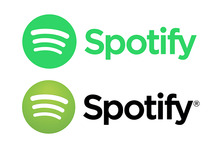Web Design Tools
Graphic & Web Design Tools That Will Explode in 2015
Webydo
A B2B hybrid platform that combines both web design and development in one, Webydo is a great choice for designers looking to create website designs without needing to hand write code or rely on a web developer to help them. One of the most exciting features in Webydo is the ability to create “pixel-perfect responsive web designs” that work great on a variety of devices.
Webydo allows designers to begin with an existing design or layout or to start from scratch with a drag and drop interface. You simply design in the web editor and it writes the code for you. Popular site features, like animated carousels, can also be added without needing to write code, making Webydo is a tool that could quickly become a favorite for many designers.
Invision
If you need a better way to present your ideas and design work to clients, one that goes beyond just static images of interface designs, then Invision may be exactly what you need. This prototyping tool allows you to turn your designs into interactive prototypes. Transitions and animations, along with real-time design and collaboration capabilities and version control and sync capabilities, make Invision a multi-faceted tool that may fit a number of needs for designers.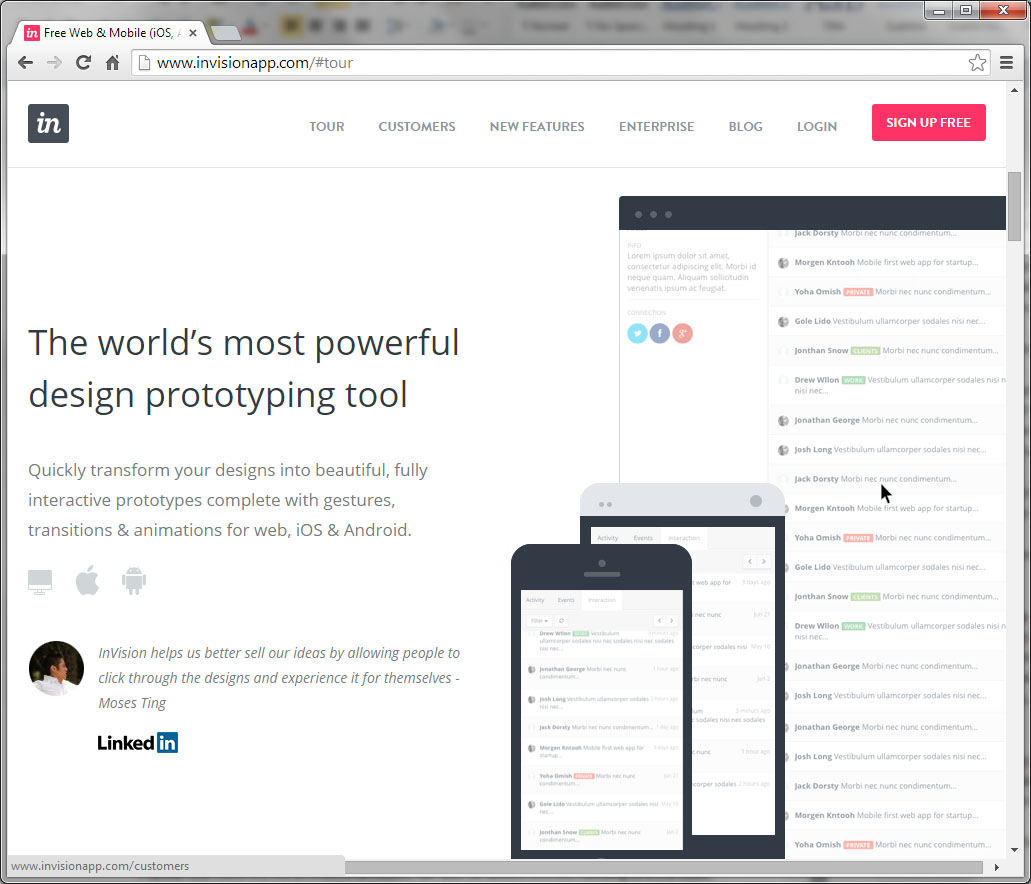
Ink
Responsive web design has become a best practice and many websites now support a variety of devices with a responsive layout – but what about emails? Ink allows you to easily create “responsive HTML emails that work on any device.” They go on to add that their emails work in “even Outlook”, a sore point for many designers who have to work on HTML emails and who struggle to make them work well in Outlook!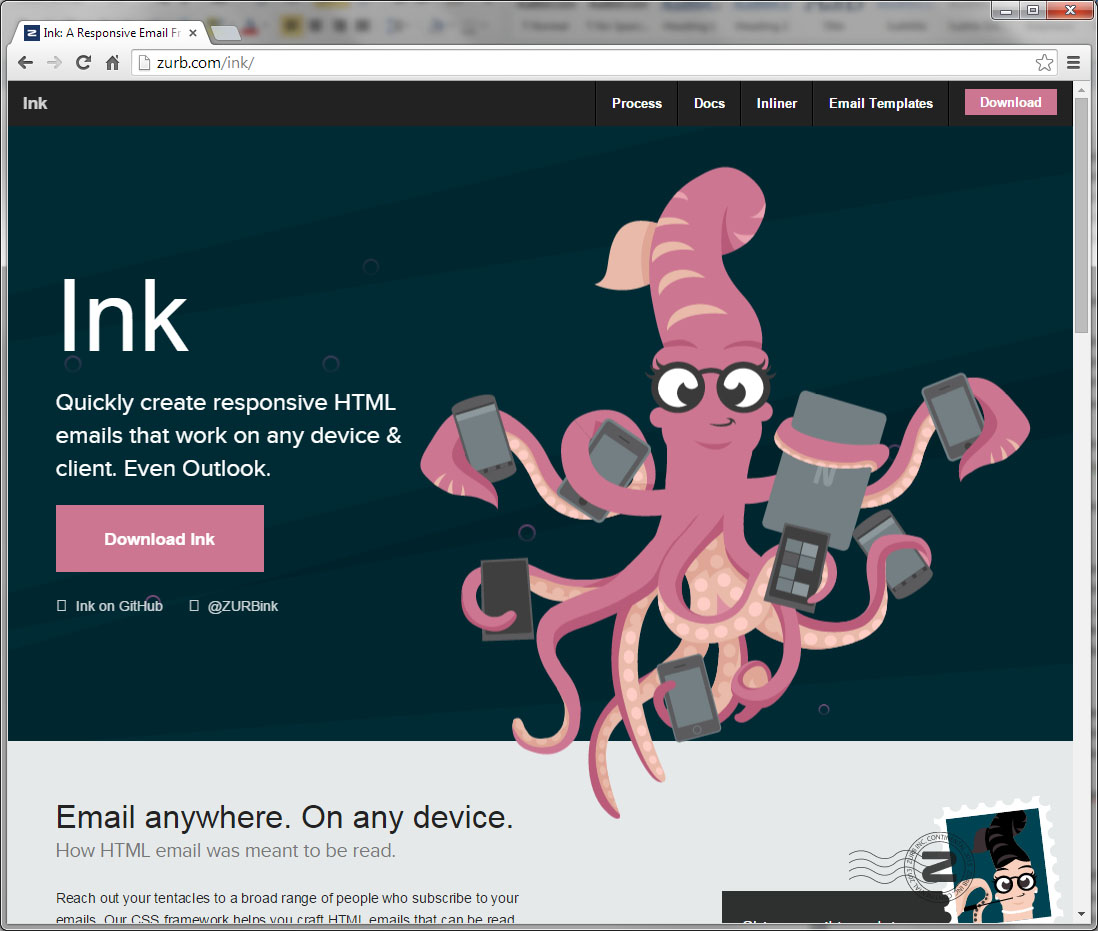
Ink, which was created by the company ZURB, offers a number of templates on their website so that you can begin using the system, and sending responsive HTML emails, quickly.
Infogram
If a picture is worth a thousand words, than a good infographic could be priceless! Infogram is a “data visualization product” that allows you to quickly and easily turn your data into infographics, charts, and even interactive visualizations. There are over 30 interactive chart types available in the system currently; covering a wide range of data visualization needs for websites, presentations, and other instances where a picture will explain much more than text alone.
Infogram offers a free account with a host of features, but paid accounts open up even more functionality. For designers or agencies, there is even a white label option that allows you to add your own logo and brand this solution with your own company’s identity.
Pixlr
While Adobe Photoshop is an industry standard tool that many designers swear by, some of those designers may not want to pay the monthly fee to license that software. For them, Pixlr may be worth a look!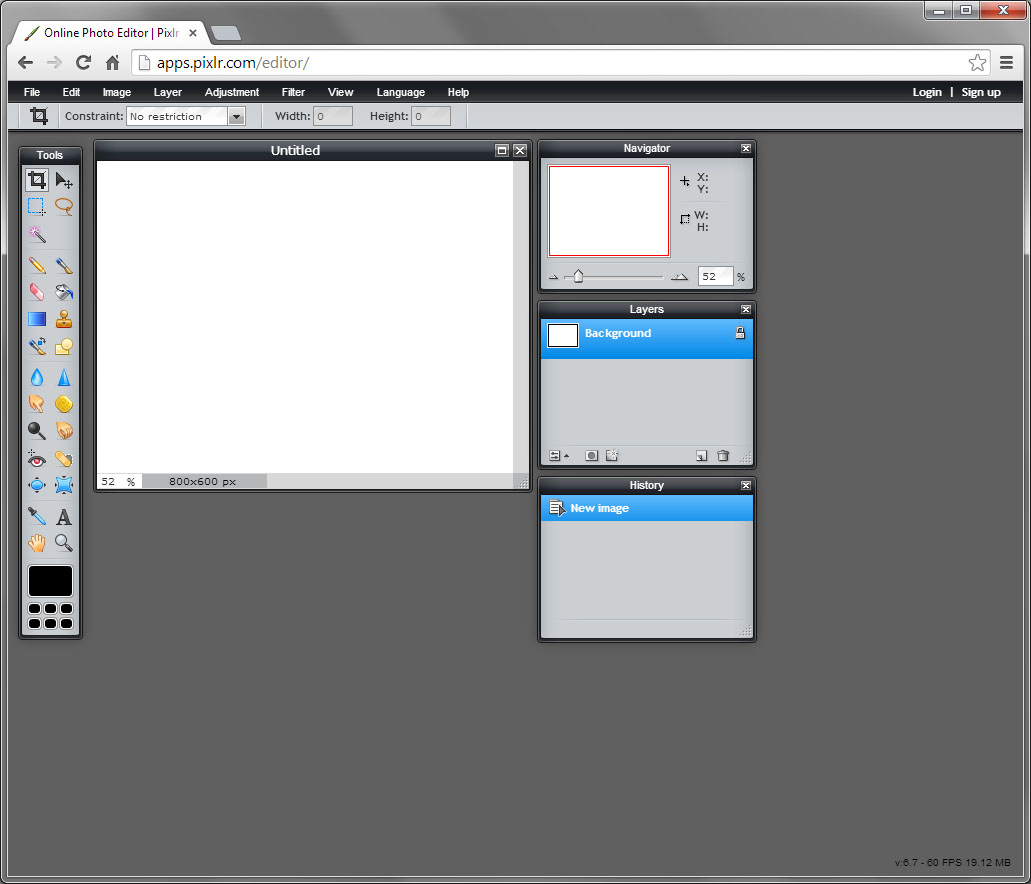
If you’ve used Photoshop before, then the “Pixlr Editor” will be very familiar. Pixlr even opens .PSD files and retains all the original layers, making it a great alternative to Photoshop. Another good use of Pixlr is for clients who have very simple image editing needs (resize, crop, etc.). I recommend this to my clients all the time, allowing them to get all the functionality they need without having to worry about another software license to maintain.
Note: Pixlr and Creative Market are both Autodesk products.
Rinse
One of the most effective ways to get your ideas or message across online is through storytelling. Rinse provides photographers with a unique way to display a portfolio of their work and tell the stories behind that work. Basic accounts allow you to upload one story, while Advanced accounts, which are by invitation only, allow up to 10 stories to be shared.
While Rinse is undoubtedly a great resource for photographers looking to share their work, it is also a wonderful site for fans of stunning photography and can offer inspiration to other designers on how images can be used to tell compelling and powerful stories online.
Material-UI
Material Design is Google’s visual language, including specifications on animation, style (color, icons, images, typography), layout, components, patterns, and more . Material-UI is a “CSS Framework and a Set of React Components that Implement Google's Material Design.”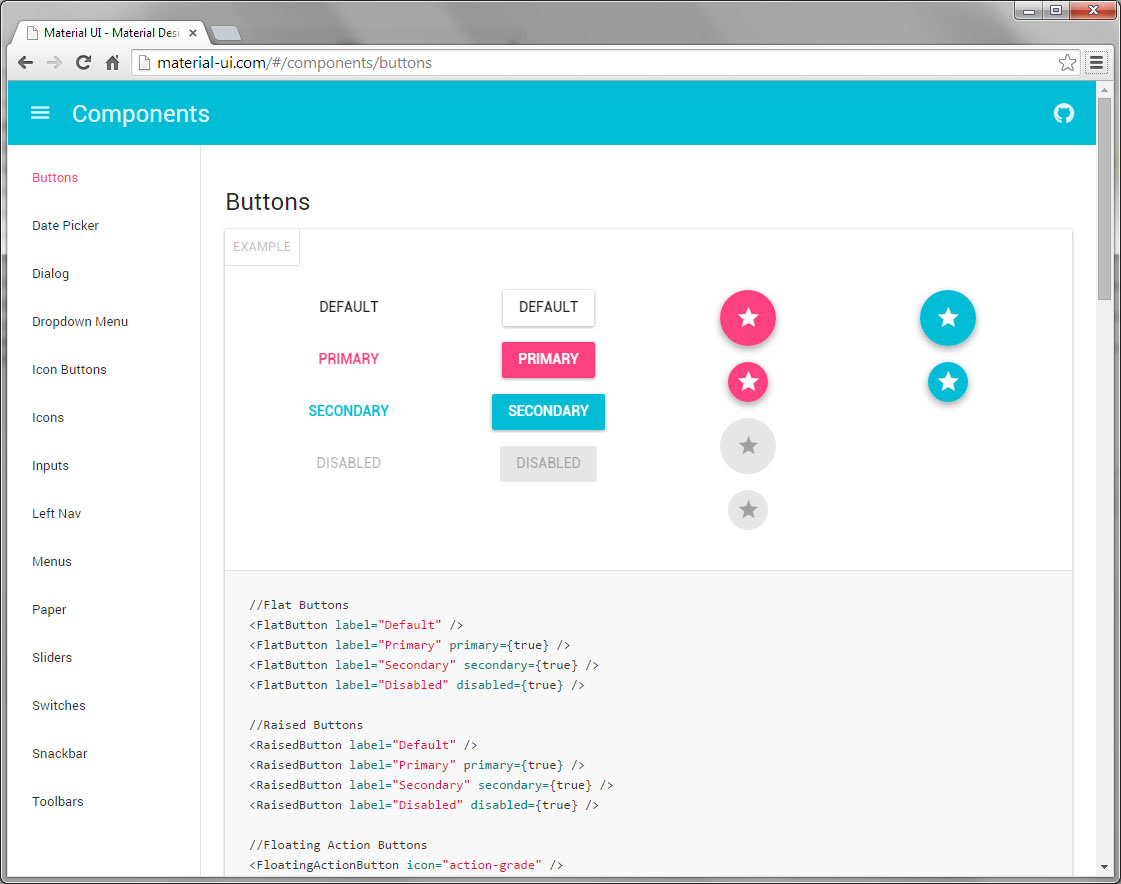
The Material-UI website includes example projects for you to look at, as well as instructions on how to begin using this visual language in your own projects.
Frameless
If you need “an easy way to preview prototypes on iOS devices”, then Frameless for iOS 8 is here for you. With a transparent UI and customizable gestures (swipe, tap with three fingers, shake the device, etc.), Frameless is perfect for prototyping and previewing any HTML content in a native context.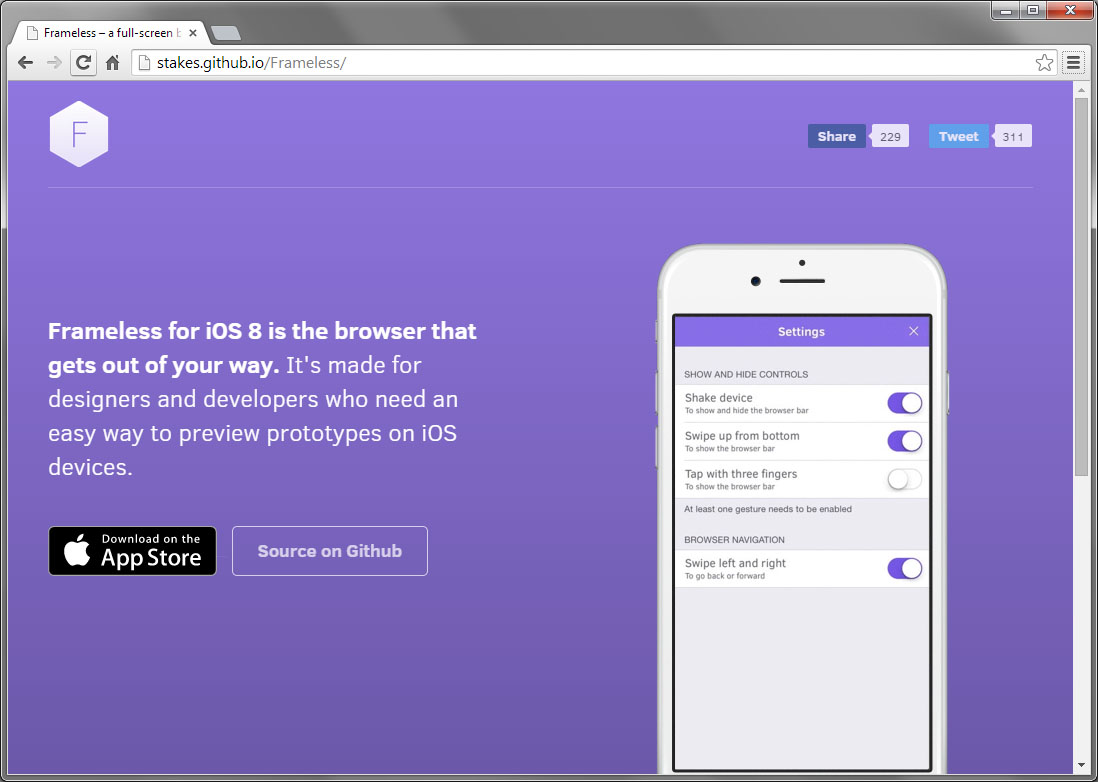
Typegenius
This tool is pretty straightforward. In fact, the text on their homepage sums it up pretty succinctly by saying “Find the perfect font combo for your next project.” Select a starter font from the drop down list of available choices and the site will give you some examples of fonts that pair well with that selection. They even include a visual example of the two fonts being used together in a design so you can see how they look side by side.
This is a potentially very helpful tool for combining font choices, and as more fonts are added to their system, this tool will become even more valuable and give designers even more combinations to review and consider!
Skillshare
This website is “a learning community for creators.” Classes are offered in a variety of topics, including many different design disciplines, and those classes include short lessons and hands-on projects to help you learn the materials. You can also share your work with the community on Skillshare, a nice feature for learners who want more than just some video tutorials.
Free Skillshare accounts give you access to a number of classes, but for a small fee (currently $8/month), you will have unlimited access to all the classes they offer. Additionally, in line with their focus on “community”, for every annual membership they sell on the site, they donate a free membership to a student in need.
What Else?
Now it's time for you to make some predictions. Which graphic and web design tools do you think will take off in 2015? Leave a comment below with your prediction.Web Applications of india
Web Applications: What are They? What of Them?
Web Applications or Website Widgets
Over the past decade or so, the web has been embraced by millions of businesses as an inexpensive channel to communicate and exchange information with prospects and transactions with customers.In particular, the web provides a way for marketers to get to know the people visiting their sites and start communicating with them. One way of doing this is asking web visitors to subscribe to newsletters, to submit an application form when requesting information on products or provide details to customize their browsing experience when next visiting a particular website.
The web is also an excellent sales channel for a myriad of organizations, large or small: with over 1 billion Internet users today (source: Computer Industry Almanac, 2006), US e-commerce spending accounted for $102.1 billion in 2006 (Source: comScore Networks, 2007).
All this data must be somehow captured, stored, processed and transmitted to be used immediately or at a later date. Web applications, in the form of submit fields, enquiry and login forms, shopping carts, and content management systems, are those website widgets that allow this to happen.
They are, therefore, fundamental to businesses for leveraging their online presence thus creating long-lasting and profitable relationships with prospects and customers.
No wonder web applications have become such a ubiquitous phenomenon. However, due to their highly technical and complex nature, web applications are a widely unknown and a grossly misunderstood fixture in our everyday cyber-life.
Web applications defined
From a technical view-point, the web is a highly programmable environment that allows mass customization through the immediate deployment of a large and diverse range of applications, to millions of global users. Two important components of a modern website are flexible web browsers and web applications; both available to all and sundry at no expense.Web browsers are software applications that allow users to retrieve data and interact with content located on web pages within a website.
Today’s websites are a far cry from the static text and graphics showcases of the early and mid-nineties: modern web pages allow personalized dynamic content to be pulled down by users according to individual preferences and settings. Furthermore, web pages may also run client-side scripts that “change” the Internet browser into an interface for such applications as web mail and interactive mapping software (e.g., Yahoo Mail and Google Maps).
Most importantly, modern web sites allow the capture, processing, storage and transmission of sensitive customer data (e.g., personal details, credit card numbers, social security information, etc.) for immediate and recurrent use. And, this is done through web applications. Such features as webmail, login pages, support and product request forms, shopping carts and content management systems, shape modern websites and provide businesses with the means necessary to communicate with prospects and customers. These are all common examples of web applications.
Web applications are, therefore, computer programs allowing website visitors to submit and retrieve data to/from a database over the Internet using their preferred web browser. The data is then presented to the user within their browser as information is generated dynamically (in a specific format, e.g. in HTML using CSS) by the web application through a web server.
For the more technically oriented, Web applications query the content server (essentially a content repository database) and dynamically generate web documents to serve to the client (people surfing the website). The documents are generated in a standard format to allow support by all browsers (e.g., HTML or XHTML). JavaScript is one form of client side script that permits dynamic elements on each page (e.g., an image changes once the user hovers over it with a mouse). The web browser is key – it interprets and runs all scripts etc. while displaying the requested pages and content. Wikipedia brilliantly terms the web browser as the “universal client for any web application”.
Another significant advantage of building and maintaining web applications is that they perform their function irrespective of the operating system and browsers running client side. Web applications are quickly deployed anywhere at no cost and without any installation requirements (almost) at the user’s end.
As the number of businesses embracing the benefits of doing business over the web increases, so will the use of web applications and other related technologies continue to grow. Moreover, since the increasing adoption of intranets and extranets, web applications become greatly entrenched in any organization’s communication infrastructures, further broadening their scope and possibility of technological complexity and prowess.
Web applications may either be purchased off-the-shelf or created in-house.
How do web applications work?
The figure below details the three-layered web application model. The first layer is normally a web browser or the user interface; the second layer is the dynamic content generation technology tool such as Java servlets (JSP) or Active Server Pages (ASP), and the third layer is the database containing content (e.g., news) and customer data (e.g., usernames and passwords, social security numbers and credit card details).The figure below shows how the initial request is triggered by the user through the browser over the Internet to the web application server. The web application accesses the databases servers to perform the requested task updating and retrieving the information lying within the database. The web application then presents the information to the user through the browser.
Web Security Issues
Despite their advantages, web applications do raise a number of security concerns stemming from improper coding. Serious weaknesses or vulnerabilities, allow hackers to gain direct and public access to databases in order to churn sensitive data. Many of these databases contain valuable information (e.g., personal and financial details) making them a frequent target of hackers. Although such acts of vandalism as defacing corporate websites are still commonplace, nowadays, hackers prefer gaining access to the sensitive data residing on the database server because of the immense pay-offs in selling the data.In the framework described above, it is easy to see how a hacker can quickly access the data residing on the database through a dose of creativity and, with luck, negligence or human error, leading to vulnerabilities in the web applications.
As stated, websites depend on databases to deliver the required information to visitors. If web applications are not secure, i.e., vulnerable to, at least one of the various forms of hacking techniques, then your entire database of sensitive information is at serious risk.
Some hackers, for example, may maliciously inject code within vulnerable web applications to trick users and redirect them towards phishing sites. This technique is called Cross-Site Scripting and may be used even though the web servers and database engine contain no vulnerability themselves.
Recent research shows that 75% of cyber attacks are done at web application level.
- Websites and related web applications must be available 24 hours a day, 7 days a week, to provide the required service to customers, employees, suppliers and other stakeholders.
- Firewalls and SSL provide no protection against web application hacking, simply because access to the website has to be made public – All modern database systems (e.g. Microsoft SQL Server, Oracle and MySQL) may be accessed through specific ports (e.g., port 80 and 443) and anyone can attempt direct connections to the databases effectively bypassing the security mechanisms used by the operating system. These ports remain open to allow communication with legitimate traffic and therefore constitute a major vulnerability.
- Web applications often have direct access to backend data such as customer databases and, hence, control valuable data and are much more difficult to secure. Those that do not have access will have some form of script that allows data capture and transmission. If a hacker becomes aware of weaknesses in such a script, he may easily reroute unwitting traffic to another location and illegitimately hive off personal details.
- Most web applications are custom-made and, therefore, involve a lesser degree of testing than off-the-shelf software. Consequently, custom applications are more susceptible to attack
This is the work of a web vulnerability scanner.
Acunetix Web Vulnerability Scanner
Proof of such exploits are readily available on the Internet and are the subject of discussion in several press releases by Acunetix, a leading vendor of web application security products. Click here to learn more about Acunetix Web Vulnerability Scanner.Scanning for XSS vulnerabilities with Acunetix WVS Free Trial
To check whether your website has cross site scripting vulnerabilities, download the 14-day Trial of Acunetix WVS. This version will scan any website / web application for XSS vulnerabilities and it will also reveal all the essential information related to it, such as the vulnerability location and remediation techniques. Scanning for XSS is normally a quick exercise (depending on the size of the web-site).Web Applications: What are They? What of Them?
Web Applications or Website Widgets
Over the past decade or so, the web has been embraced by millions of businesses as an inexpensive channel to communicate and exchange information with prospects and transactions with customers.In particular, the web provides a way for marketers to get to know the people visiting their sites and start communicating with them. One way of doing this is asking web visitors to subscribe to newsletters, to submit an application form when requesting information on products or provide details to customize their browsing experience when next visiting a particular website.
The web is also an excellent sales channel for a myriad of organizations, large or small: with over 1 billion Internet users today (source: Computer Industry Almanac, 2006), US e-commerce spending accounted for $102.1 billion in 2006 (Source: comScore Networks, 2007).
All this data must be somehow captured, stored, processed and transmitted to be used immediately or at a later date. Web applications, in the form of submit fields, enquiry and login forms, shopping carts, and content management systems, are those website widgets that allow this to happen.
They are, therefore, fundamental to businesses for leveraging their online presence thus creating long-lasting and profitable relationships with prospects and customers.
No wonder web applications have become such a ubiquitous phenomenon. However, due to their highly technical and complex nature, web applications are a widely unknown and a grossly misunderstood fixture in our everyday cyber-life.
Web applications defined
From a technical view-point, the web is a highly programmable environment that allows mass customization through the immediate deployment of a large and diverse range of applications, to millions of global users. Two important components of a modern website are flexible web browsers and web applications; both available to all and sundry at no expense.Web browsers are software applications that allow users to retrieve data and interact with content located on web pages within a website.
Today’s websites are a far cry from the static text and graphics showcases of the early and mid-nineties: modern web pages allow personalized dynamic content to be pulled down by users according to individual preferences and settings. Furthermore, web pages may also run client-side scripts that “change” the Internet browser into an interface for such applications as web mail and interactive mapping software (e.g., Yahoo Mail and Google Maps).
Most importantly, modern web sites allow the capture, processing, storage and transmission of sensitive customer data (e.g., personal details, credit card numbers, social security information, etc.) for immediate and recurrent use. And, this is done through web applications. Such features as webmail, login pages, support and product request forms, shopping carts and content management systems, shape modern websites and provide businesses with the means necessary to communicate with prospects and customers. These are all common examples of web applications.
Web applications are, therefore, computer programs allowing website visitors to submit and retrieve data to/from a database over the Internet using their preferred web browser. The data is then presented to the user within their browser as information is generated dynamically (in a specific format, e.g. in HTML using CSS) by the web application through a web server.
For the more technically oriented, Web applications query the content server (essentially a content repository database) and dynamically generate web documents to serve to the client (people surfing the website). The documents are generated in a standard format to allow support by all browsers (e.g., HTML or XHTML). JavaScript is one form of client side script that permits dynamic elements on each page (e.g., an image changes once the user hovers over it with a mouse). The web browser is key – it interprets and runs all scripts etc. while displaying the requested pages and content. Wikipedia brilliantly terms the web browser as the “universal client for any web application”.
Another significant advantage of building and maintaining web applications is that they perform their function irrespective of the operating system and browsers running client side. Web applications are quickly deployed anywhere at no cost and without any installation requirements (almost) at the user’s end.
As the number of businesses embracing the benefits of doing business over the web increases, so will the use of web applications and other related technologies continue to grow. Moreover, since the increasing adoption of intranets and extranets, web applications become greatly entrenched in any organization’s communication infrastructures, further broadening their scope and possibility of technological complexity and prowess.
Web applications may either be purchased off-the-shelf or created in-house.
How do web applications work?
The figure below details the three-layered web application model. The first layer is normally a web browser or the user interface; the second layer is the dynamic content generation technology tool such as Java servlets (JSP) or Active Server Pages (ASP), and the third layer is the database containing content (e.g., news) and customer data (e.g., usernames and passwords, social security numbers and credit card details).The figure below shows how the initial request is triggered by the user through the browser over the Internet to the web application server. The web application accesses the databases servers to perform the requested task updating and retrieving the information lying within the database. The web application then presents the information to the user through the browser.
Web Security Issues
Despite their advantages, web applications do raise a number of security concerns stemming from improper coding. Serious weaknesses or vulnerabilities, allow hackers to gain direct and public access to databases in order to churn sensitive data. Many of these databases contain valuable information (e.g., personal and financial details) making them a frequent target of hackers. Although such acts of vandalism as defacing corporate websites are still commonplace, nowadays, hackers prefer gaining access to the sensitive data residing on the database server because of the immense pay-offs in selling the data.In the framework described above, it is easy to see how a hacker can quickly access the data residing on the database through a dose of creativity and, with luck, negligence or human error, leading to vulnerabilities in the web applications.
As stated, websites depend on databases to deliver the required information to visitors. If web applications are not secure, i.e., vulnerable to, at least one of the various forms of hacking techniques, then your entire database of sensitive information is at serious risk.
Some hackers, for example, may maliciously inject code within vulnerable web applications to trick users and redirect them towards phishing sites. This technique is called Cross-Site Scripting and may be used even though the web servers and database engine contain no vulnerability themselves.
Recent research shows that 75% of cyber attacks are done at web application level.
- Websites and related web applications must be available 24 hours a day, 7 days a week, to provide the required service to customers, employees, suppliers and other stakeholders.
- Firewalls and SSL provide no protection against web application hacking, simply because access to the website has to be made public – All modern database systems (e.g. Microsoft SQL Server, Oracle and MySQL) may be accessed through specific ports (e.g., port 80 and 443) and anyone can attempt direct connections to the databases effectively bypassing the security mechanisms used by the operating system. These ports remain open to allow communication with legitimate traffic and therefore constitute a major vulnerability.
- Web applications often have direct access to backend data such as customer databases and, hence, control valuable data and are much more difficult to secure. Those that do not have access will have some form of script that allows data capture and transmission. If a hacker becomes aware of weaknesses in such a script, he may easily reroute unwitting traffic to another location and illegitimately hive off personal details.
- Most web applications are custom-made and, therefore, involve a lesser degree of testing than off-the-shelf software. Consequently, custom applications are more susceptible to attack
This is the work of a web vulnerability scanner.
Acunetix Web Vulnerability Scanner
Proof of such exploits are readily available on the Internet and are the subject of discussion in several press releases by Acunetix, a leading vendor of web application security products. Click here to learn more about Acunetix Web Vulnerability Scanner.Scanning for XSS vulnerabilities with Acunetix WVS Free Trial
To check whether your website has cross site scripting vulnerabilities, download the 14-day Trial of Acunetix WVS. This version will scan any website / web application for XSS vulnerabilities and it will also reveal all the essential information related to it, such as the vulnerability location and remediation techniques. Scanning for XSS is normally a quick exercise (depending on the size of the web-site).Web design Terms and Conditions
Terms and Conditions
1. STANDARD TERMS AND CONDITIONS
2. OUR FEES AND DEPOSITS
3. SUPPLY OF MATERIALS
4. VARIATIONS
5. PROJECT DELAYS AND CLIENT LIABILITY
6. APPROVAL OF WORK
7. REJECTED WORK
8. PAYMENT
9. WARRANTY BY YOU AS TO OWNERSHIP OF INTELLECTUAL PROPERTY RIGHTS
10. LICENSING
11. SEARCH ENGINES
12. CONSEQUENTIAL LOSS
13. DISCLAIMER
14. SUBCONTRACTING
15. NON-DISCLOSURE
16. ADDITIONAL EXPENSES
17. BACKUPS
18. OWNERSHIP OF DOMAIN NAMES AND WEB HOSTING
19. GOVERNING LAW
20. CROSS BROWSER COMPATIBILITY
21. E-COMMERCE
Subscribe to:
Posts (Atom)
More Web Update and News
-
-
-
-
-
-
-
-
-
-
-
-
-
-
-
-
-
-
-
-
-
-
-
-
-
-
-
Establishing Trust in the Age of AI2 weeks ago
-
-
Loewe3 weeks ago
-
-
-
-
-
-
-
-
Dép sục nam HY1813 EVA siêu nhẹ6 months ago
-
-
-
-
-
-
-
-
-
-
-
-
-
-
-
-
-
-
-
-
-
-
-
-
-
-
-
-
-
-
-
-
Design Tips for Mobile Checkout Screens7 years ago
-
Design Tips for Mobile Checkout Screens7 years ago
-
-
-
-
Easier Way to Manage Feedback8 years ago
-
-
-
-
The state of design tools in 20178 years ago
-
-
Css3 Menu with HTML5 Tutorial8 years ago
-
Extravaganza – September 20168 years ago
-
-
-
-
-
-
New Website9 years ago
-
Seting up HTML5 file9 years ago
-
-
-
-
-
-
RSNetworking 210 years ago
-
-
-
-
-
-
-
-
-
-
Auto Insurance and Leasing12 years ago
-
attune infocom12 years ago
-
How to seo Wordpress Websites13 years ago
-
-
Rent textbooks14 years ago
-
-
-
-
ASP.NET SEO Basics16 years ago
-
-
-
-
-
-
-
-



